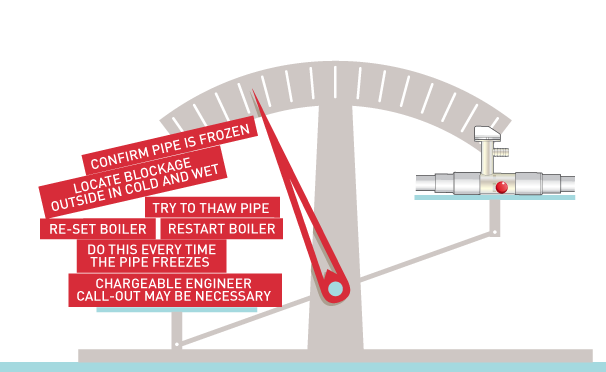Homeowner: Steps may have to be taken if your condensing boiler fails in cold weather
Boiler Buoy: The simple, speedy, safe solution to restart your boiler without having to go out in the cold
 The diagram, above, graphically shows all the steps needed to be taken every time your external condensate pipe freezes. This could happen many times across a very cold winter, meaning repeated trips out into the cold to sort the problem, or costly call-out charges from an engineer, each time.
The diagram, above, graphically shows all the steps needed to be taken every time your external condensate pipe freezes. This could happen many times across a very cold winter, meaning repeated trips out into the cold to sort the problem, or costly call-out charges from an engineer, each time.
If you find yourself in this situation, the measures are shown below in more detail, to help solve the problem. Alternatively, take steps before this occurs, and fit one of the options outlined on this site, that best suits your circumstances and budget.
Information from the Heating & Hotwater Industry Council (HHIC)
If you have an external condensate drainage pipe, (and in some cases, unheated interior termination), your boiler is at risk of locking out if the pipe freezes. This will leave your home without heat and hot water, in the coldest conditions – just when you need them.
If this happens, you can either try to sort the problem yourself, *(provided you feel competent to take the actions described. If you do not feel competent to follow this guidance then you should contact your regular servicing organisation or a local Gas Safe registered engineer, explain the situation and arrange for them to resolve the problem. They will also be able to advise on ways to reduce the likelihood of freezing in future. Registered gas engineers in your area can be found using the postcode search facility on the Gas Safe Register website at www.gassaferegister.co.uk)
There are a number of measures, detailed below, which householders can take in order to thaw a frozen condensate drainage pipe, free the blockage and re-start the boiler themselves provided they feel competent to do so*.
1. Confirm that a frozen condensate drain pipe is the cause of shutdown.
It is important to confirm that a frozen condensate drainage pipe is the likely cause of the problem before taking any of the remedial actions suggested below. The condensate drainage pipe is a plastic pipe (typically grey or white in colour) connected to the bottom of your boiler.
If the following circumstances apply then it is probable that a frozen condensate drainage pipe is the cause -
- outside temperatures have been below freezing for some time.
- the condensate drainage pipe runs through the wall and outside the property for part of its length, without any increased pipe diameter, any insulation on it, or other measures to prevent freezing. There may also be a problem if the pipe runs through an enclosed but unheated area, such as a garage or loft.
- the boiler has previously been working satisfactorily
Shutdown due to freezing and blockage of the condensate drainage pipe will usually be indicated by a “fault code” on the boiler’s digital display, although this may not specifically indicate freezing as the fault. Indication may also be given by some other alarm such as a flashing light, or by a symptom such as “gurgling” noises coming from the boiler.
Note 1: Please refer to the boiler manual for guidance on fault codes/alarms and their meaning – the boiler manufacturer or the servicing company you use may also have a helpline or website giving guidance on this.
2. Locate the blockage.
It is likely that the pipe is frozen at the most exposed point external to the building or where there is some obstruction to flow. This could be at the open end of the pipe, at a bend or elbow, or where there is a dip in the pipe in which condensate can collect. The location of the blockage should be identified as closely as possible before taking further action.
3. Thaw the frozen pipe.
The pipe can be thawed by applying a hot water bottle, a microwaveable heating pack (the sort used for muscular aches and pains) or cloths soaked in warm water to the exterior of the pipe, close to the likely point of blockage. Warm water can also be poured onto the pipe from a watering can or similar container. Do not use boiling water.
Note 2: You should not attempt to thaw a condensate drain pipe if you cannot easily reach it from ground level. Be aware that any water used can quickly freeze if it falls onto pathways – causing a possible slip hazard.
4. Reset/re-start the boiler.
Once the blockage has been thawed and cleared, consult the boiler operating instructions or check the manufacturer’s website for guidance on any action needed to “reset” the fault code/alarm and re-start the boiler.
In most cases, once the condensate drain pipe is cleared and a reset has been carried out, the boiler will re-ignite using an automatic operating sequence.
If this reset/restart does not succeed you should call in a competent engineer to assess the situation and take further action if required. Registered gas engineers in your area can be found using the postcode search facility on the Gas Safe Register website at www.gassaferegister.co.uk
5. Temporary remedial actions:
If the pipe is successfully thawed and the boiler can be re-started then the following temporary remedial actions may help prevent re-freezing if the severe weather continues.
- If the external pipe is not insulated as recommended, you should try to rectify this by attaching suitable water-proof and weather-proof insulation over the outside of the pipe to prevent re-freezing. “Class O” pipe insulation is suitable for external use and should be available from DIY outlets and plumbing/heating suppliers.
- During the cold spell it may help to temporarily run the heating system with the boiler thermostat (as distinct from the room thermostat) set to maximum. Turn back to the normal setting used once the cold spell is over.
- It may also help to temporarily set the central heating timer/programmer to “continuous” (24hr) mode, setting the room thermostat overnight to around 15oC . Again, return to the normal settings once the cold spell is over.
6. Longer term actions:
As previously stated, British Standards, Building Regulations etc. currently allow condensate drainage pipes to run either internally or externally, or a combination of these. These documents give recommendations on how to run the pipe and use insulation, if required, in order to reduce the possibility of freezing, This guidance was based on prevailing UK winter conditions, however it may not be sufficient to prevent freezing in extreme conditions of the type experienced over recent years.
Should you wish to take action in order to reduce the risk of freezing in future, either by relocating the condensate drainage pipe or by taking other measures, then more detailed guidance is available from your heating installer, service engineer.

 The Boiler Buoy Condensate Bypass Valve can be purchased through leading plumbing and heating merchants.
The Boiler Buoy Condensate Bypass Valve can be purchased through leading plumbing and heating merchants. 


Comments are closed.